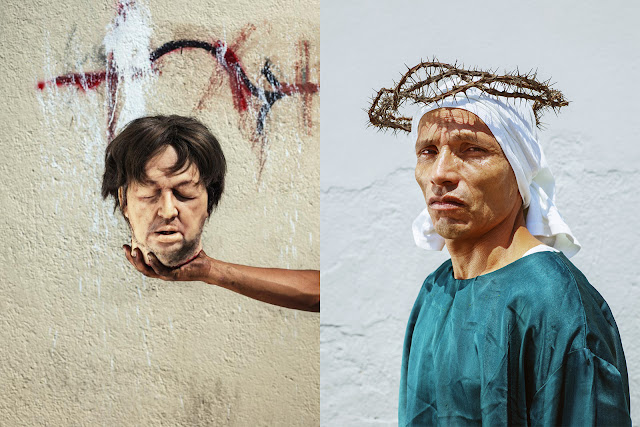 |
La Cucaracha. By Pieter Hugo.
|
Photographs by Pieter Hugo
RM, 2020. In English.
136 pp., 56 illustrations, 12¼x13¾".
Invited by the curator Francisco Berzunza to create a body of work on the themes of sexuality and death in Mexico, Pieter Hugo responded with La Cucaracha. The book is big, blood red, and opens with a picture of a disembodied head. In the pages that follow, Hugo offers an electric memento mori captured in a land riddled by violence. As a photographer inspired by symbols and media images, Hugo draws here from the visual history of Catholic iconography, Biblical stories, Mexican folklore, Aztec culture, Renaissance painting, and drug cartel crime scenes. The result is a Mexican fever dream that retains the hallmarks of Hugo’s distinct oeuvre.
 |
| La Cucaracha. By Pieter Hugo. |
 |
| La Cucaracha. By Pieter Hugo. |
Of Mexico, Hugo observes: “There is an acceptance that life has no glorious victory, no happy ending.” Naked figures—exiled Adams and Eves—populate the book: a couple embraces in a barren landscape, a sex worker poses suggestively, a massive snake coils around a man. Hugo mixes the mundane in with the metaphorical, taking care to represent Mexico’s innocent visions, including its fruits and flowers. His clothed subjects offer proof that the people’s daily life indeed goes on, and Hugo treats their resilience with reverence. Interspersed portraits — such as a chambermaid, a mango vendor, a photographer and his family, and a girl in her first communion dress—interrupt the spin of myth and history, periodically jolting the viewer into everyday reality.
 |
| La Cucaracha. By Pieter Hugo. |
One of the most triumphant moments in the book is Hugo’s three technicolor ‘Muxes’, which run consecutively. Ancient and modern at once, these ‘third-gendered’ men presenting as women carry on a tradition rooted in cross-dressing Aztec priests and the Mayan gods who embodied both sexes. Their prominent presence in La Cucaracha celebrates Mexico’s capacity to grapple with ambiguity, and to endure.
Purchase Book
Read More Book Reviews
*All Pieter Hugo quotes from: Hugo, Pieter (2019) ‘Finding a Home for your Demons’, July, The Eye of Photography.
 |
| La Cucaracha. By Pieter Hugo. |
 |
| La Cucaracha. By Pieter Hugo. |









